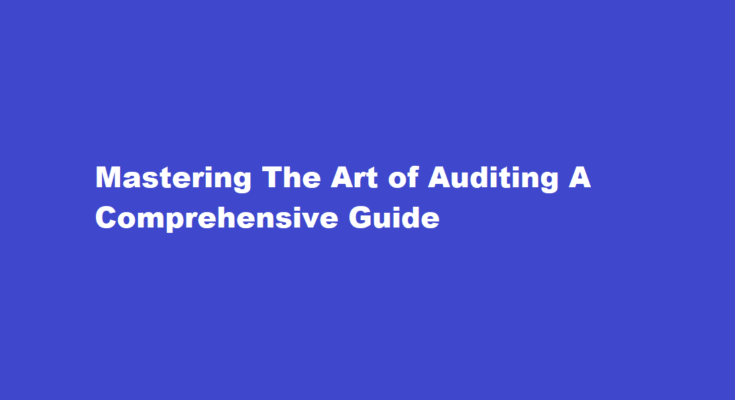Introduction
Auditing is a critical process that ensures transparency, accuracy, and compliance within an organization’s financial and operational activities. Whether it’s a small business, a multinational corporation, or a government agency, the principles of auditing remain consistent. In this article, we will delve into the key steps and strategies involved in conducting effective audits.
Understanding the Types of Audits
Audits come in various forms, each serving a specific purpose. Financial audits focus on verifying financial statements for accuracy, while operational audits evaluate internal processes. Compliance audits ensure adherence to regulations, and information systems audits assess IT controls. Understanding the type of audit required lays the foundation for a successful auditing process.
Preparing for the Audit
Thorough preparation is essential. Define the audit scope, objectives, and criteria. Gather relevant documents, policies, and procedures. Establish a clear timeline and select a capable audit team. The audit plan should outline tasks, responsibilities, and communication channels.
Risk Assessment
Identify potential risks and prioritize them based on their impact. Understanding risks helps tailor the audit procedures to address specific concerns, ensuring the efficient allocation of resources.
Data Collection
Collect pertinent data and evidence related to the audit criteria. Use various methods, including interviews, document reviews, and observation. Ensure the information collected is reliable, relevant, and sufficient to draw accurate conclusions.
Examination and Evaluation
Thoroughly examine the collected data. Compare it against the established criteria to identify discrepancies, anomalies, or non-compliance. Evaluate the significance of these findings in relation to the audit objectives.
Root Cause Analysis
If issues are uncovered, delve into their root causes. This analysis provides insights into systemic problems that may require corrective actions beyond surface-level fixes.
Communication
Clear communication is vital. Report findings to relevant stakeholders, highlighting both positive and negative aspects. Use a balanced and unbiased approach to foster trust and cooperation.
Recommendations and Corrective Actions
Offer practical recommendations to address identified issues. These recommendations should be actionable, specific, and tailored to the organization’s context. Collaborate with the management to develop feasible corrective action plans.
Follow-Up
Monitor the implementation of corrective actions. Follow up at designated intervals to ensure changes are being made effectively. This step reinforces accountability and demonstrates the organization’s commitment to improvement.
Continuous Improvement
Every audit presents an opportunity to enhance processes. After each audit, conduct a thorough review of the audit process itself. Identify areas for improvement in terms of efficiency, effectiveness, and value-added insights.
Professional Skepticism
Maintain a skeptical mindset throughout the audit process. While trust is important, auditors must critically assess information and remain alert to potential red flags.
Ethics and Independence
Ethical conduct is paramount. Auditors must maintain independence from the subjects of their audits, ensuring unbiased evaluations. Adhere to professional standards and codes of ethics.
FREQUENTLY ASKED QUESTIONS
What is an audit checklist?
An audit checklist may be a document or tool that facilitates an audit programme which contains documented information such as the scope of the audit, evidence collection, audit tests and methods, analysis of the results as well as the conclusion and follow up actions such as corrective and preventive actions.
Can I do my own audit?
While a basic audit can be performed by the business owner (who should be regularly making sure financial information is accurate and procedures are efficient), it is wise to hire a CPA to do a systematic overview of your finances.
Conclusion
Auditing is a multifaceted process that requires careful planning, rigorous execution, and effective communication. By following these steps and embracing the principles of accuracy, transparency, and professionalism, auditors can provide invaluable insights that drive organizational growth and success. Remember, effective auditing is not just about identifying problems but also about facilitating positive change.
In conclusion, mastering the art of auditing involves a structured approach that encompasses various stages from preparation to continuous improvement. By adhering to ethical principles, maintaining independence, and fostering open communication, auditors play a pivotal role in enhancing an organization’s performance and credibility.
Read Also : Mastering The Art of Effective Management A Comprehensive Guide



